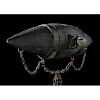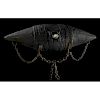Exceptionally Rare and Historically Significant Confederate Rains Barrel Torpedo
About Seller
6270 Este Ave.
Cincinnati , OH 45232
United States
With offices in Cincinnati, Cleveland and Denver, Cowan’s holds over 40 auctions each year, with annual sales exceeding $16M. We reach buyers around the globe, and take pride in our reputation for integrity, customer service and great results. A full-service house, Cowan’s Auctions specializes in Am...Read more
Two ways to bid:
- Leave a max absentee bid and the platform will bid on your behalf up to your maximum bid during the live auction.
- Bid live during the auction and your bids will be submitted real-time to the auctioneer.
Bid Increments
| Price | Bid Increment |
|---|---|
| $0 | $25 |
| $500 | $50 |
| $1,000 | $100 |
| $2,000 | $250 |
| $5,000 | $500 |
| $10,000 | $1,000 |
| $20,000 | $2,500 |
| $50,000 | $5,000 |
| $100,000 | $10,000 |
About Auction
May 2, 2018 - May 4, 2018
Cowan's Auctions dawnie@cowans.com
- Lot Description
45" in overall length, 40" in diameter at widest point. Main body of barrel 17” in length with two tapered, pointed ends, each roughly 14” in length. Tar-covered body secured by six riveted iron straps, with two 1.8” iron bails at the ends to secure the chains for the mushroom anchor to hold the torpedo in place. Two fuse mounts are present along the center line of the torpedo body, measuring 4.5” x 5” with threaded receptacles to accept Rains sensitive primer fuses. Turned brass fuses are 4.5” in overall length, 1.44” in diameter with a 1.5” long 10tpi threaded base and 3” body exposed from the mount. Torpedo includes a modern 50” tall display stand made of iron chain, which mimics the method by which the torpedo was submerged and anchored when in use. Two pieces of loose chain at the ends of the display mount can be attached to the bails of the torpedo to complete the look. The stand has a 21” diameter chain base.
The Rains Barrel Torpedo, which today would be referred to as a “mine,” was the invention of James Gabriel Rains, who served as Chief of the Confederate Torpedo Service. Rains developed several explosive devices for use by the Confederacy during the Civil War including “torpedoes” and “subterranean shells” (mines) for use both on land and in the water, as well as hand grenades. Rains was a North Carolina native who attended the US Military Academy at West Point, graduating 13th in his class of 1827. Rains was a career military man, who rose from the rank of Brevet 2nd Lieutenant to Lieutenant Colonel during his 30+ year career in the United States Army. Rains saw service with the 7th US Infantry initially, rising slowly through the ranks to Captain, which he attained in 1837. In 1851, he achieved the rank of Major and was transferred to the 4th US Infantry, and was eventually promoted to Lieutenant Colonel of the 5th US Infantry in 1860.
He received the brevet rank of Major for gallantry in 1840 while fighting the Seminoles near Fort King, FL. In addition to fighting during the Seminole Wars Rains fought in the Mexican American War, and although he was on the brink of being elevated to the level of regimental or even brigade command at the outset of the Civil War, he resigned his commission in the US Army on July 31, 1861 in response to the secession of his native state of North Carolina. In the fall of 1861 Rains was commissioned into the Confederate Army with the rank of Colonel of Infantry and was almost immediately promoted to the rank of Brigadier General.
Rains’ experience with the use of torpedoes in the field of combat began during the Peninsular Campaign, when he used artillery shells as ersatz land mines in the defenses around Yorktown. The success of these devices greatly impressed Rains’ commanding officer General McGruder, who on April 8, 1862, just days after the initial contact of the campaign, penned a letter to Richmond recommending that Rains be promoted to Major General which read in part: “Considering the circumstances under which Brigadier General Rains is placed, the importance of his position and the great services that he has rendered, I recommend that he be appointed Major General.”
While this promotion never materialized, it was probably the catalyst that brought Rains and his explosive experiments to the forefront of the general staff in Richmond and likely was the catapult that launched him into service with the Torpedo Bureau that was established soon thereafter, in October of 1862. This new position allowed Rains to explore the development and production of more refined devices for use on both land in the water. The use of torpedoes to protect southern ports and waterways was an ingenious method of maximizing destruction to the enemy while minimizing the forces needed to defend a specific area. As manpower was always a severely limiting factor for the Confederacy, the ability to use autonomous destructive devices that required no personnel to man or operate was a real boon. The first major success of Rains’ Torpedo Bureau was the sinking of the USS Cairo in the Yazoo River on December 12, 1862, making the Cairo the first ship to be sunk by a water borne mine during the Civil War. Rains would later comment during post-war reminiscence that while iron clad ships might be protected from the shells of other ships and shore batteries, there was no protection that their armor provided against mines. His opinion was bolstered by a post-Civil War US naval report that noted that US naval losses to torpedoes were greater than by all other causes combined, and further noted that “the torpedo service of the Confederacy probably contributed more to its defense by far than all the vessels of the Confederate Navy.”
While Rains’ devices were relatively effective, they did have flaws. Initial designs that were simply repurposed barrels or kegs did not ride well in the water, resulting in the adoption of pointed ends to improve their stability. Effective anchor systems had to be developed to make sure the torpedoes remained where they were supposed to be and were not moved about by the current. There were also constant issues with the torpedoes being rendered inert due to long term submersion in the water. The fuses were prone to corrosion, rendering them inert and a poorly sealed torpedo, filled with wet gunpowder would not explode. It was these factors that allowed Admiral David Farragut the ability to shout the famous words “Damn the torpedoes! Full speed ahead!” during his assault on Mobile Bay and live to bask in the glory of his utterance. Had the numerous Rains torpedoes that were deployed in the defense of the bay not been rendered inert from long exposure to the water and the corrosive effects of the salt, many (if not most) of Farragut’s fleet might well have been sunk. As it was, only the monitor Tecumseh was sunk by a Rains torpedo, although many commanders reported hearing their ships strike the numerous submerged torpedoes as they moved into the harbor.
Today, an original Rains Barrel Torpedo is among the rarest of all Confederate Ordnance and Naval related artifacts, with only three original examples extant. This example remains in wonderfully well preserved condition and has much of the tarred finish remaining on the exterior of the barrel, which has been further preserved with a layer of black paint that has prevented any degradation to the remaining tar or the torpedo itself. The iron bands all remain tightly secured to the body of the torpedo and in the areas where the paint and tar have worn or thinned, the heavily oxidized condition of the iron from the time the mine spent in the water is clearly obvious. The wood shows some minor shrinking and some gaps have opened between the main barrel of the body and the cone shaped ends. Two Rains sensitive pressure fuse bodies are present in the mounts on the barrel, and have probably been added at some point in time. They are most likely museum grade replicas that have the appearance of the original fuses. One fuse is frozen in its mount while the other is removable. The fuses show the corrosion and discoloration appropriate to brass that was exposed to the corrosive effects of salt air for some time, but not with long term immersion. One fuse retains its leather washer to help seal the exposed body of the fuse against the mount. Neither fuse retains its brass, screw-off protective cap, and both of the lead pressure caps show dings and dents. Overall a truly fine condition example of an extraordinary piece of Confederate history that would be the penultimate centerpiece to the most advanced collection of Confederate Naval or Ordnance artifacts.
Eliminate the Hassle of Third-Party Shippers: Let Cowan's Ship Directly To You!Condition
If you'd like a shipping estimate before the auction, contact Cowan's in-house shipping department at shipping@cowans.com or 513.871.1670 x219. - Shipping Info
-
Eliminate the Hassle of Third-Party Shippers: Let Cowan's Ship Directly To You!
If you'd like a shipping estimate before the auction, contact Cowan's in-house shipping department at shipping@cowans.com or 513.871.1670 x219.
At the request of the buyer, Cowan's will authorize the shipment of purchased items. Shipments usually occur within two weeks after payment has been received. Shipment is generally made via UPS Ground service. Unless buyer gives special instructions, the shipping method shall be at the sole discretion of Cowan's Auctions, Inc.. Cowan's is in no way responsible for the acts or omissions of independent handlers, packers or shippers of purchased items or for any loss, damage or delay from the packing or shipping of any property.
-
- Buyer's Premium



 EUR
EUR CAD
CAD AUD
AUD GBP
GBP MXN
MXN HKD
HKD CNY
CNY MYR
MYR SEK
SEK SGD
SGD CHF
CHF THB
THB
















